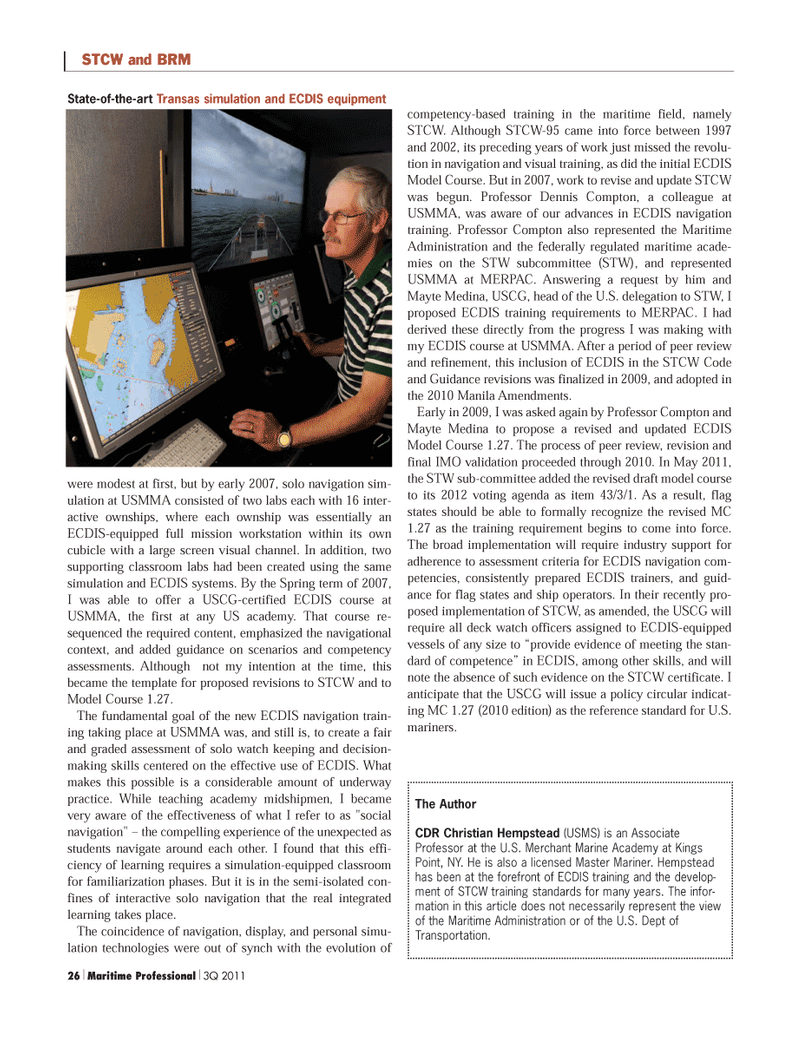
Page 26: of Maritime Logistics Professional Magazine (Q3 2011)
Maritime Security / Maritime Training & Education
Read this page in Pdf, Flash or Html5 edition of Q3 2011 Maritime Logistics Professional Magazine
26 Maritime Professional 3Q 2011were modest at first, but by early 2007, solo navigation sim- ulation at USMMA consisted of two labs each with 16 inter- active ownships, where each ownship was essentially an ECDIS-equipped full mission workstation within its own cubicle with a large screen visual channel. In addition, two supporting classroom labs had been created using the samesimulation and ECDIS systems. By the Spring term of 2007,I was able to offer a USCG-certified ECDIS course at USMMA, the first at any US academy. That course re- sequenced the required content, emphasized the navigational context, and added guidance on scenarios and competency assessments. Although not my intention at the time, this became the template for proposed revisions to STCW and to Model Course 1.27.The fundamental goal of the new ECDIS navigation train- ing taking place at USMMA was, and still is, to create a fair and graded assessment of solo watch keeping and decision- making skills centered on the effective use of ECDIS. What makes this possible is a considerable amount of underway practice. While teaching academy midshipmen, I became very aware of the effectiveness of what I refer to as "social navigation" ? the compelling experience of the unexpected as students navigate around each other. I found that this effi- ciency of learning requires a simulation-equipped classroom for familiarization phases. But it is in the semi-isolated con- fines of interactive solo navigation that the real integrated learning takes place. The coincidence of navigation, display, and personal simu- lation technologies were out of synch with the evolution of competency-based training in the maritime field, namely STCW. Although STCW-95 came into force between 1997 and 2002, its preceding years of work just missed the revolu- tion in navigation and visual training, as did the initial ECDIS Model Course. But in 2007, work to revise and update STCW was begun. Professor Dennis Compton, a colleague at USMMA, was aware of our advances in ECDIS navigation training. Professor Compton also represented the MaritimeAdministration and the federally regulated maritime acade- mies on the STW subcommittee (STW), and representedUSMMA at MERPAC. Answering a request by him and Mayte Medina, USCG, head of the U.S. delegation to STW, I proposed ECDIS training requirements to MERPAC. I had derived these directly from the progress I was making with my ECDIS course at USMMA. After a period of peer review and refinement, this inclusion of ECDIS in the STCW Code and Guidance revisions was finalized in 2009, and adopted in the 2010 Manila Amendments. Early in 2009, I was asked again by Professor Compton and Mayte Medina to propose a revised and updated ECDIS Model Course 1.27. The process of peer review, revision and final IMO validation proceeded through 2010. In May 2011, the STW sub-committee added the revised draft model course to its 2012 voting agenda as item 43/3/1. As a result, flag states should be able to formally recognize the revised MC 1.27 as the training requirement begins to come into force. The broad implementation will require industry support foradherence to assessment criteria for ECDIS navigation com- petencies, consistently prepared ECDIS trainers, and guid-ance for flag states and ship operators. In their recently pro-posed implementation of STCW, as amended, the USCG will require all deck watch officers assigned to ECDIS-equipped vessels of any size to ?provide evidence of meeting the stan- dard of competence? in ECDIS, among other skills, and willnote the absence of such evidence on the STCW certificate. I anticipate that the USCG will issue a policy circular indicat- ing MC 1.27 (2010 edition) as the reference standard for U.S.mariners.STCW and BRMState-of-the-art Transas simulation and ECDIS equipment The AuthorCDR Christian Hempstead(USMS) is an AssociateProfessor at the U.S. Merchant Marine Academy at Kings Point, NY. He is also a licensed Master Mariner. Hempstead has been at the forefront of ECDIS training and the develop- ment of STCW training standards for many years. The infor- mation in this article does not necessarily represent the view of the Maritime Administration or of the U.S. Dept ofTransportation. MP #3 (18-33):MP Layouts 8/17/2011 4:09 PM Page 26

 25
25

 27
27
